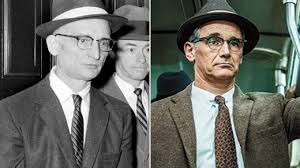The bridge of the title in the latest film directed by
Steven Spielberg is The Glienicke Bridge that connects Berlin to Potsdam and
was one of many border crossings between the West and the East during the cold war
that followed World War 2 and the annexing of Germany. The eastern part of the bridge is in the West
and the western part is in the East, the border between the Socialist German
Democratic Republic (GDR) and the Capitalist Federal Republic of Germany (DDR)runs
through the middle of it. In 1961 following the GDR’s attempt to secure their
border the bridge could only be used as a border crossing point for Allied
military personnel or if special permission was granted.
Glienicke Bridge gained fame because it was where ‘agent’
exchanges took place between the USA and the Soviet Union. The most famous of
these exchanges was on the 10th February 1962 between the US U-2 spy
plane pilot Francis Gary Powers, the all American boy who could not follow
orders, who was shot down on the 1st May 1960 and the Soviet
Intelligence Officer Colonel Rudolf Ivanovich Abel who was put on trial and
accused of spying on the USA from an apartment in New York for a nine year period.
Abel whose real name was Vilyam Genrikhovich Fisher was born in the United
Kingdom in Newcastle upon Tyne he was the son of Russian émigré’s and whose
father Heinrich was a Bolshevik freedom fighter.
Although it’s this true story that forms the backbone of Bridge
of Spies (2015) Spielberg’s movie mainly concentrates on the American insurance
lawyer James B Donovan who in 1945 had assisted at the Nuremberg war trials and
was tasked with defending Colonel Abel in 1957 and to broker the subsequent
prisoner exchange in 1962. The American actor Tom Hanks ably covers this part,
but it’s the British actor Mark Rylance who takes all the plaudits for his role
as the very likable Colonel Abel.
 |
| The same bridge on my last visit in August 2012. |
This is a rather enjoyable old-fashioned cold war thriller
that brings to mind movies like The
Spy Who Came in from the Cold (1965) and is made even better by the
script which was co written by Matt Charman and the Coen Brothers. The
historical accuracy is obviously stretched – well it is a Hollywood movie – and
we get a typical soft US ending just like we did with Spielberg’s Lincoln (2012) but I would still
recommend you to see this movie if for no other reason than to spend an
enjoyable couple of hours in your local cinema.




Just have to correct one little factual error in your intro. GDR = DDR (Deutsche Demokratische Republik), the 'Capitalist Federal Republic' aka West Germany was the FRG = BRD (Bundesrepublik Deutschland). You would of course expect yours truly not to let that past!
ReplyDelete